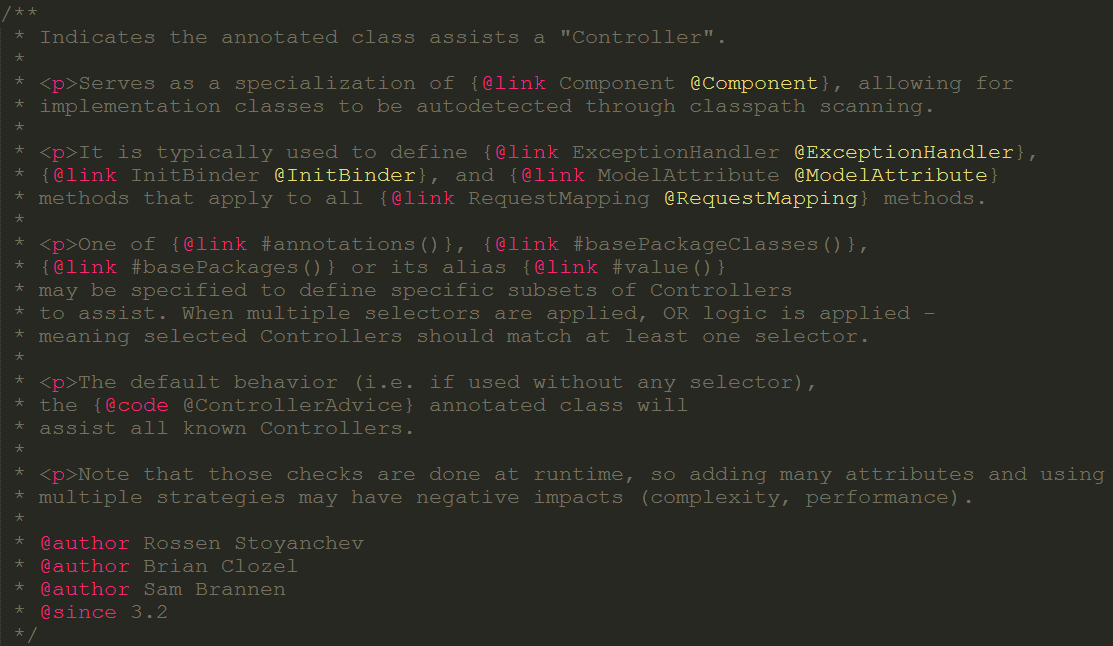@ControllerAdvice,是Spring3.2提供的新注解,从名字上可以看出大体意思是控制器增强。让我们先看看@ControllerAdvice的实现:
package org.springframework.web.bind.annotation;
@Target(ElementType.TYPE)
@Retention(RetentionPolicy.RUNTIME)
@Documented
@Component
public @interface ControllerAdvice {
@AliasFor("basePackages")
String[] value() default {};
@AliasFor("value")
String[] basePackages() default {};
Class<?>[] basePackageClasses() default {};
Class<?>[] assignableTypes() default {};
Class<? extends Annotation>[] annotations() default {};
}
没什么特别之处,该注解使用@Component注解,这样的话当我们使用<context:component-scan>扫描时也能扫描到。
再一起看看官方提供的comment。
大致意思是:
-
@ControllerAdvice是一个@Component,用于定义@ExceptionHandler,@InitBinder和@ModelAttribute方法,适用于所有使用@RequestMapping方法。 -
Spring4之前,
@ControllerAdvice在同一调度的Servlet中协助所有控制器。Spring4已经改变:@ControllerAdvice支持配置控制器的子集,而默认的行为仍然可以利用。 -
在Spring4中,
@ControllerAdvice通过annotations(),basePackageClasses(),basePackages()方法定制用于选择控制器子集。
不过据经验之谈,只有配合@ExceptionHandler最有用,其它两个不常用。
在SpringMVC重要注解(一)@ExceptionHandler和@ResponseStatus我们提到,如果单使用@ExceptionHandler,只能在当前Controller中处理异常。但当配合@ControllerAdvice一起使用的时候,就可以摆脱那个限制了。
package com.somnus.advice;
import org.springframework.web.bind.annotation.ControllerAdvice;
import org.springframework.web.bind.annotation.ExceptionHandler;
import org.springframework.web.bind.annotation.ResponseBody;
@ControllerAdvice
public class ExceptionAdvice {
@ExceptionHandler({ ArrayIndexOutOfBoundsException.class })
@ResponseBody
public String handleArrayIndexOutOfBoundsException(Exception e) {
e.printStackTrace();
return "testArrayIndexOutOfBoundsException";
@Controller
@RequestMapping(value = "exception")
public class ExceptionHandlerController {
@RequestMapping(value = "e2/{id}", method = { RequestMethod.GET })
@ResponseBody
public String testExceptionHandle2(@PathVariable(value = "id") Integer id) {
List<String> list = Arrays.asList(new String[]{"a","b","c","d"});
return list.get(id-1);
}
}
当我们访问http://localhost:8080/SpringMVC/exception/e2/5的时候会抛出ArrayIndexOutOfBoundsException异常,这时候定义在@ControllerAdvice中的@ExceptionHandler就开始发挥作用了。
如果我们想定义一个处理全局的异常
package com.somnus.advice;
import javax.servlet.http.HttpServletRequest;
import org.springframework.core.annotation.AnnotationUtils;
import org.springframework.web.bind.annotation.ControllerAdvice;
import org.springframework.web.bind.annotation.ExceptionHandler;
import org.springframework.web.bind.annotation.ResponseBody;
import org.springframework.web.bind.annotation.ResponseStatus;
@ControllerAdvice
public class ExceptionAdvice {
@ExceptionHandler({ Exception.class })
@ResponseBody
public String handException(HttpServletRequest request ,Exception e) throws Exception {
e.printStackTrace();
return e.getMessage();
}
}
乍一眼看上去毫无问题,但这里有一个纰漏,由于Exception是异常的父类,如果你的项目中出现过在自定义异常中使用@ResponseStatus的情况,你的初衷是碰到那个自定义异常响应对应的状态码,而这个控制器增强处理类,会首先进入,并直接返回,不会再有@ResponseStatus的事情了,这里为了解决这种纰漏,我提供了一种解决方式。
package com.somnus.advice;
import javax.servlet.http.HttpServletRequest;
import org.springframework.core.annotation.AnnotationUtils;
import org.springframework.web.bind.annotation.ControllerAdvice;
import org.springframework.web.bind.annotation.ExceptionHandler;
import org.springframework.web.bind.annotation.ResponseBody;
import org.springframework.web.bind.annotation.ResponseStatus;
@ControllerAdvice
public class ExceptionAdvice {
@ExceptionHandler({ Exception.class })
@ResponseBody
public String handException(HttpServletRequest request ,Exception e) throws Exception {
e.printStackTrace();
//If the exception is annotated with @ResponseStatus rethrow it and let
// the framework handle it - like the OrderNotFoundException example
// at the start of this post.
// AnnotationUtils is a Spring Framework utility class.
if (AnnotationUtils.findAnnotation(e.getClass(), ResponseStatus.class) != null){
throw e;
}
// Otherwise setup and send the user to a default error-view.
/*ModelAndView mav = new ModelAndView();
mav.addObject("exception", e);
mav.addObject("url", request.getRequestURL());
mav.setViewName(DEFAULT_ERROR_VIEW);
return mav;*/
return e.getMessage();
}
}
如果碰到了某个自定义异常加上了@ResponseStatus,就继续抛出,这样就不会让自定义异常失去加上@ResponseStatus的初衷。

